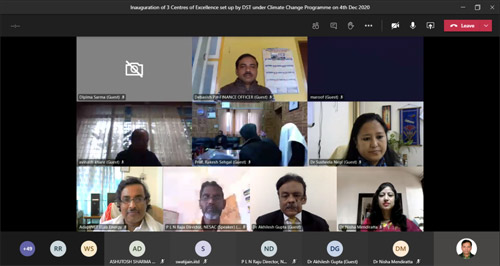 Three Centre of Excellence (CoE) set up under National Mission for Sustaining the Himalayan Ecosystem (NMSHE) at Central Universities from two North-Eastern states, and Kashmir were inaugurated by Secretary Department of Science & Technology (DST) Professor Ashutosh Sharma, December 4, 2020, through Video Conferencing.
Three Centre of Excellence (CoE) set up under National Mission for Sustaining the Himalayan Ecosystem (NMSHE) at Central Universities from two North-Eastern states, and Kashmir were inaugurated by Secretary Department of Science & Technology (DST) Professor Ashutosh Sharma, December 4, 2020, through Video Conferencing.
Professor Sharma urged these centres to lead the climate change research in the Himalayan region while inaugurating the centres at the University of Kashmir, and Sikkim University and Tezpur University that have been established by the Department of Science and Technology (DST). He highlighted the importance of focusing on relevant interventions in this region which is the third pole and is both a contributor to climate change and regulator of it.
He stressed that the centres should be the primary movers of producing knowledge and also using that knowledge with the help of appropriate stakeholders and also be a source of motivation for Himalayan Universities to come forward to take up research challenges.
“Out of the 8 national missions which are part of the National Action Plan on Climate Change, NMSHE is the only site-specific mission that aims to take suitable measures for safeguarding the Indian Himalayan Region. With capacity building the major focus of NMSHE, we have set up Climate Change (CC) cells in 12 out of the 13 states and Union territories of Himalayan region and will soon have 13th state CC cell in Ladakh,” he added.
Prof. S.P. Singh, Chairman Expert Committee of DST on Climate Change programme appreciated the setting up of the centres in the two parts of the Himalaya and said: “DST has played a proactive role as co-developers of the projects and activities in this mission and is taking a corrective measure by giving importance to universities of the Himalayan region to boost their research.”
“The Himalayan region offers several systems where research can be done, whether it is glaciers, forests or alpine meadows. We should take advantage of these systems which offer a system to answer many of the questions and are of global interest,” he pointed out.
 Dr Akhilesh Gupta, Adviser and Head, SPLICE-Climate Change programme DST explained that in order to drive the research leadership in the 145 Universities in the Indian Himalayan region and address challenges like inadequate R&D infrastructure especially in climate change, lack of quality manpower and encourage institutional centric research, a thorough mapping based on capacity building requirement was done by DST. The three CoEs set up at Kashmir, Tezpur and Sikkim Universities were part of outcome of this mapping exercise.
Dr Akhilesh Gupta, Adviser and Head, SPLICE-Climate Change programme DST explained that in order to drive the research leadership in the 145 Universities in the Indian Himalayan region and address challenges like inadequate R&D infrastructure especially in climate change, lack of quality manpower and encourage institutional centric research, a thorough mapping based on capacity building requirement was done by DST. The three CoEs set up at Kashmir, Tezpur and Sikkim Universities were part of outcome of this mapping exercise.
Prof. Talat Ahmad, Vice-Chancellor Kashmir University, pointed out that there are more than 13000 glaciers in the Himalaya and study of these need development of a large workforce with expertise in this field.
Prof. V. K. Jain, Vice-Chancellor, Tezpur University underlined the necessity of a centre in the Northeast which is home to a significant proportion of the tribal community with a need to deal with issues related to their sustainable livelihood.
Prof. Avinash Khare, Vice-Chancellor Sikkim University said this CoE will help in the capacity building of the Sikkim University by strengthening fieldwork and other research and infrastructure facilities.
Dr Nisha Mendiratta, Associate Head SPLICE-Climate Change programme DST said that NMSHE seeks to facilitate the formulation of appropriate policy measures and time-bound action programmes to sustain ecological resilience and ensure the continued provisions of key ecosystem services in the Himalaya, evolving suitable management and policy measures for sustaining and safeguarding the Himalayan ecosystem.






























